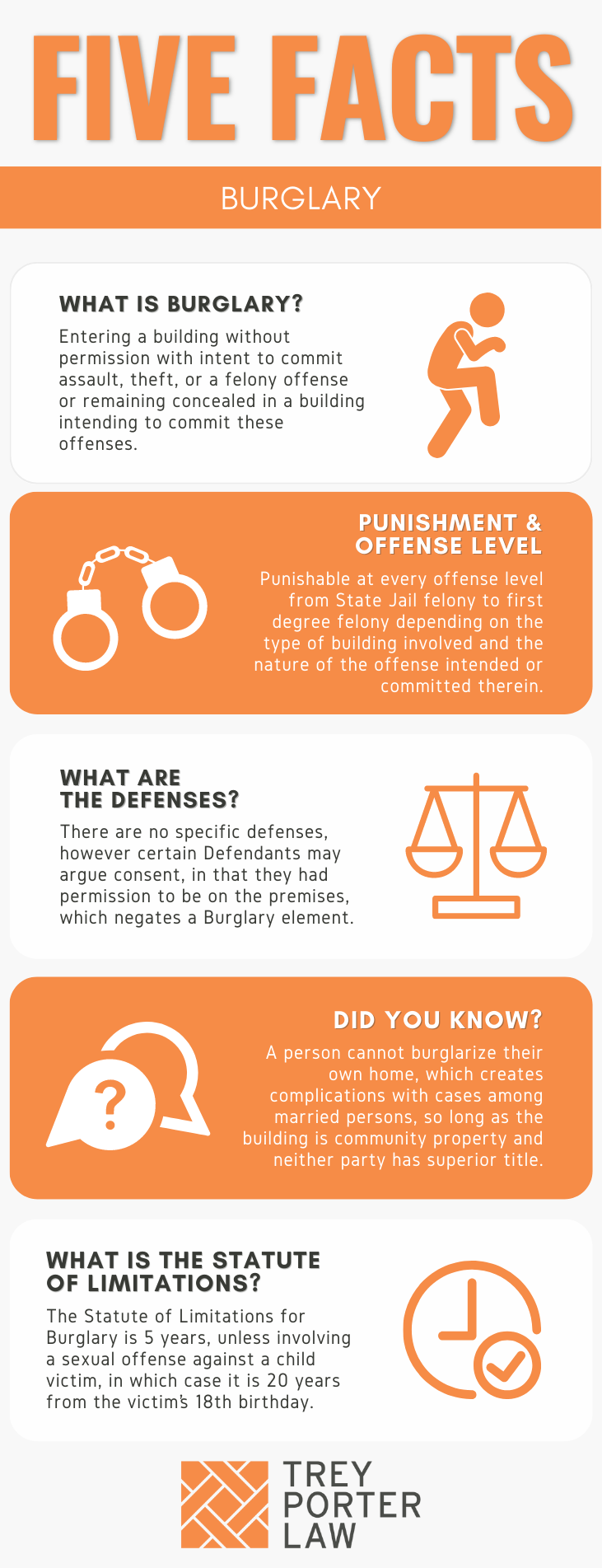WHAT IS BURGLARY IN TEXAS?
The Texas law against burglary prohibits entering a home or building with the intent to commit theft, assault, or any felony offense, regardless of whether the person attempts or fails to successfully commit the offense. Burglary may also be committed by legally entering but remaining concealed in a home or building, with the intent to commit theft, assault, or any other felony.

WHAT IS THE BURGLARY LAW IN TEXAS?
Tex. Penal Code § 30.02. BURGLARY.
(a) A person commits an offense if, without the effective consent of the owner, the person:
(1) enters a habitation, or a building (or any portion of a building) not then open to the public, with intent to commit a felony, theft, or an assault; or
(2) remains concealed, with intent to commit a felony, theft, or an assault, in a building or habitation; or
(3) enters a building or habitation and commits or attempts to commit a felony, theft, or an assault.
. . .
(c) Except as provided in Subsection (c-1) or (d), an offense under this section is a:
(1) state jail felony if committed in a building other than a habitation; or
(2) felony of the second degree if committed in a habitation.
(c-1) An offense under this section is a felony of the third degree if:
(1) the premises are a commercial building in which a controlled substance is generally stored, including a pharmacy, clinic, hospital, nursing facility, or warehouse; and
(2) the person entered or remained concealed in that building with intent to commit a theft of a controlled substance.
(d) An offense under this section is a felony of the first degree if:
(1) the premises are a habitation; and
(2) any party to the offense entered the habitation with intent to commit a felony other than felony theft or committed or attempted to commit a felony other than felony theft.
WHAT IS THE PENALTY CLASS FOR BURGLARY IN TEXAS?
The penalty category for burglary depends on the location burglarized, and the person’s intent once inside.
- First degree felony, punishable by five to 99 years or life in prison:
- Burglary of a habitation during which any party to the offense entered the habitation with the intent to commit a felony, except for felony theft;
- Burglary of a habitation during which any party to the offense committed or attempted to commit a felony, except for felony theft.
- Second degree felony, punishable by two to 20 years in prison:
- Burglary of a habitation, with the intent to commit theft or assault;
- Burglary of a habitation during which an assault or theft was attempted or committed.
- Third degree felony, punishable by two to ten years in prison:
- Burglary of a commercial building in which a controlled substance is stored, such as a pharmacy, clinic, hospital, nursing facility, or warehouse.
- State jail felony, punishable by 180 days to two years in a state jail facility:
- Burglary of any other building not specifically listed above.
Burglary of a habitation with the intent to commit theft or assault is a second degree felony, punishable by two to twenty years in prison. Burglary of a building is a state jail felony, punishable by 180 days to two years in a state jail facility.
Texas Penal Code Section 12.50 increases the penalty classification for burglary to the next highest category if a person commits the offense in an area subject to an emergency evacuation order, or under a declaration of a state of disaster by the governor or president of the United States.
WHAT IS THE PUNISHMENT RANGE FOR BURGLARY IN TEXAS?
Burglary of a habitation charged as a first degree felony carries a possible five to 99 years in prison. Second-degree burglary of a habitation carries a possible two to twenty years in prison. All felonies carry a maximum $10,000 fine.
Burglary of a building charged as a third degree felony is punishable by two to ten years in prison. Burglary of a building charged as a state jail felony carries between 180 days and two years in a state jail facility, and up to a $10,000 fine.
WHAT ARE THE PENALTIES FOR BURGLARY IN TEXAS?
A person charged with burglary may be eligible for probation after a conviction, or deferred adjudication without a conviction, for up to ten years. A person charged with state jail felony burglary of a building may be placed on probation or deferred adjudication for a period between two and five years.
Pursuant to Texas Code of Criminal Procedure article 42A.054, a person is not eligible for probation after a plea to a judge if he is charged with first-degree burglary of a habitation with intent to commit continuous sexual abuse of a child or disabled individual, indecency with a child, sexual assault, aggravated sexual assault, or prohibited sexual conduct. Under those circumstances, a person is only eligible for deferred adjudication from a judge for up to ten years, or, after a guilty verdict by a jury, probation for up to ten years.
WHAT ARE THE DEFENSES TO BURGLARY IN TEXAS?
A person defending against a burglary charge may argue certain justification defenses, such as necessity. However, people typically attempt to negate one of the elements rather than admit to the conduct and try to justify it as legal. For example, one may argue consent—i.e., that he had permission to be in the home or building. It must be noted that victims of crimes such as burglary and criminal trespass may, depending on the circumstances, use deadly force in defense of property.
- Can a person who had permission to enter be charged with burglary? According to Texas Penal Code Section 30.02(a), the acts of remaining concealed without consent, and entering “any portion of a building not then open to the public,” both constitute burglary. Thus, a person lawfully inside a building may nonetheless commit burglary of a building by entering a “portion of a building not then open to the public.”For example, in Dominguez v. State, a defendant was inside a pawn shop during business hours, but reached into a jewelry case to steal a bracelet while the employee was distracted. He was convicted of burglary of a building, and the appellate court affirmed—the jewelry counter area was a portion of the building, and the jewelry showcases were not open to the public.But in Rogers v. State, Rogers went into the victim’s home he shared with his wife because the wife asked Rogers to feed her cats. While Rogers was inside, the husband/victim came home, so Rogers hid in a closet with the gun safe. The husband knew Rogers was having an affair with his wife, and suspected Rogers was inside. The husband grabbed a knife and opened the closet to attack Rogers.Rogers shot the victim between the legs, and was convicted of burglary with intent to commit assault. His conviction was reversed because he was prevented from arguing self-defense, necessity, and that he was lawfully inside the home.
- Can you burglarize your own home? Burglary is entering or remaining in a building or home without the owner’s consent. Texas Penal Code Section 1.07(35) defines “owner” as “a person who has title to the property, possession of the property, whether lawful or not, or a greater right to possession of the property than the actor.”Unless a person with a greater right to possession revokes consent for someone to be in the home, someone legally living in a home cannot burglarize it under the statute.In Morgan v. State, a defendant was living with his girlfriend at her apartment. Her name was on the lease. The victim kicked the defendant out after he assaulted her. He tried to get back in with his key, but the victim locked the deadbolt. He kicked in the door, went inside, and again assaulted the victim. He was convicted of burglary of a habitation, which was affirmed. The victim had a greater right to possession at the time of the offense, and revoked consent for the defendant to be there, so she was the “owner” under the statute.
WHAT IS THE STATUTE OF LIMITATIONS FOR BURGLARY IN TEXAS?
With a few exceptions, the limitation period for burglary is five years. If a person is charged with first-degree burglary of a habitation with the intent to commit sexual assault, aggravated sexual assault, continuous sexual abuse of a child or disabled individual, or aggravated kidnapping against a victim younger than 17 years old, the limitation period is 20 years from the 18th birthday of the victim.
BURGLARY IN TEXAS
The purpose of the burglary statute is to protect against the intrusion into a building or home where people expect such locations to be private areas. Unlike other states, Texas does not require “breaking and entering.” Even if a front door is unlocked, or open, a person entering with the intent to commit theft, assault, or any other felony commits burglary of a habitation.
The intent to commit a felony, assault, or theft also distinguishes burglary from criminal trespass. If a homeless person seeks shelter in a vacant home, the person has only committed criminal trespass of an uninhabited building.
TEXAS BURGLARY COURT CASES
The case law regarding burglary in Texas shows that a person is guilty of burglary the moment he crosses the threshold of a habitation or building without consent, and with the intent to commit the underlying offense.
- In Martinez v. State, a neighbor saw the defendant and his accomplice jump the fence into the victim’s backyard. The victim heard banging and smashing sounds, and called police. The neighbor yelled at the defendants, who ran. The victim’s back door had either been kicked in or forced open with a shoulder, with sufficient pressure to remove the deadbolt from the door jamb.The defendant was convicted, and the appellate court affirmed. “Entry” is when “the place of the opening of the house is broken,” and could be placing a foot inside a door frame, cutting window or door screens, or breaking a door lock or frame.
















